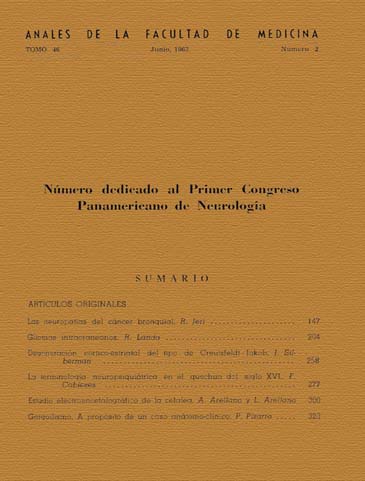The neuropathies Bronchial Cancer
DOI:
https://doi.org/10.15381/anales.v46i2.5833Abstract
The results of research conducted over ten years at the National Institute of Neoplastic Diseases on 383 consecutive patients suffering from carcinoma broncocónico are presented. Most of these patients were personally examined by the author, or by members of the Department of Neurosurgery, in order to estimate the frequency of neurological manifestations of the disease. The clinical examination was supplemented with auxiliary procedures , aimed at diagnosis of lung injury , and disturbances of the central nervous system or peripheral . As for the latter methods , neuroradiological techniques were used . electrographic , clinical and pathological ( cerebrospinal fluid) , neurosurgery (craniotomy , laminectomy) and neuropathological ( freeze biopsies , post- mortem examination ) whenever it was possible , but the predominant clinico- neurolóqíco study. since many patients could not be subject to such review procedures . In general, patients were in relatively advanced stages of the disease, and perhaps this is one of the factors that explain some aspects of the results. 40% of patients in this series had neurologic signs at the time of examination. In many cases several neurological syndromes overlap in the same patient , but as the signs in the neurological condition were distinguishable with a proper examination , it was possible to delineate four major categories : metastases cerebro- spinal , cervico- thoracic neurológiccs metastases , non-metastatic encéfaloneuromiopatías and psychological disorders. Data from 155 patients are presented in tabular form. The 11.2 % of the patients showed signs of cerebral metastases , 5.2% of spinal metastases , 13.5 % of cervical and mediastinal metastases neurolócicc , 12.5% of non-metastatic and 20.3 % encefaloneuromiopatías well-defined mental disorders . These data indicate that bronchial cancer is often manifested by neurological symptoms. Not in all cases the neurological symptoms indicates inoperability . The neuromyopathies in years may precede respiratory manifestations of the disease . In this series 40.1% of patients with brain metastasis initiated neurolóqícos condition with symptoms. The same happened in 30% of patients who had spinal metastases in 47.2% of cervical- mediastinal metastases in 33.3 % of non- metastatic encefaloneuromiopatías and in 3.5% of psychotic reactions. The diagnosis of nonmetastatic encefaloneuromiopatía can be a valuable tool in the early detection of neoplasia. However , the finding of metastatic signs in the nervous system confers a poor prognosis . Consequently , it is essential and urgent to develop socio-medical techniques for early diagnosis of bronchogenic carcinoma.Downloads
Published
1963-06-17
Issue
Section
Trabajos originales
License
Copyright (c) 1963 Raúl Jerí

This work is licensed under a Creative Commons Attribution-NonCommercial-ShareAlike 4.0 International License.
Those authors who have publications with this magazine accept the following terms:
- Authors will retain their copyrights and guarantee the journal the right of first publication of their work, which will be simultaneously subject to Creative Commons Attribution License that allows third parties to share the work as long as its author and its first publication this magazine are indicated.
- Authors may adopt other non-exclusive licensing agreements for the distribution of the version of the published work (eg, deposit it in an institutional electronic file or publish it in a monographic volume) provided that the initial publication in this magazine is indicated.
- Authors are allowed and recommended to disseminate their work over the Internet (eg: in institutional telematic archives or on their website) before and during the submission process, which It can produce interesting exchanges and increase quotes from the published work. (See El efecto del acceso abierto ).
How to Cite
1.
Jerí R. The neuropathies Bronchial Cancer. An Fac med [Internet]. 1963 Jun. 17 [cited 2024 Jul. 17];46(2):147-203. Available from: https://revistasinvestigacion.unmsm.edu.pe/index.php/anales/article/view/5833















